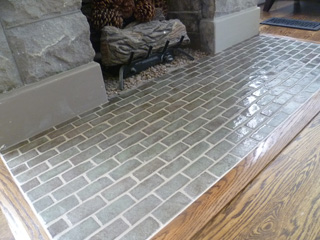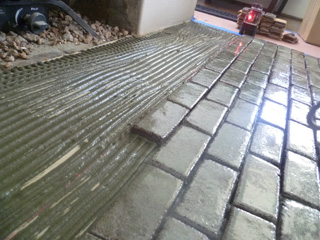 There are a multitude of choices of tile or stone for your next project, but if you want something completely unique you might look at using handmade tiles. That’s what this homeowner chose for her fireplace.
There are a multitude of choices of tile or stone for your next project, but if you want something completely unique you might look at using handmade tiles. That’s what this homeowner chose for her fireplace.
This home in the Belmont-Hillsboro neighborhood is full of old house character mixed with the homeowner’s own wonderful taste for the more contemporary. The old hearth tile just didn’t fit.
 The old tile, though not especially attractive, was in very good shape with no cracks or loose tiles. That meant that I could lay the new tile over the old by using a special mortar called Flexbond. It’s suitable for this purpose and will save a lot of the expense related to tearing out an old hearth that could mean chipping out chunks of the large concrete ‘bed’ that is likely below the tile. It’s an arduous process, but often necessary if the old tile has to go.
The old tile, though not especially attractive, was in very good shape with no cracks or loose tiles. That meant that I could lay the new tile over the old by using a special mortar called Flexbond. It’s suitable for this purpose and will save a lot of the expense related to tearing out an old hearth that could mean chipping out chunks of the large concrete ‘bed’ that is likely below the tile. It’s an arduous process, but often necessary if the old tile has to go.
The new handmade glazed tiles were a smaller subway-type. By handmade, I’d say that they were made in small batches in some sort of mold. The dimensions varied quite a bit between tiles with some being at least 1/8″ larger than others and many of the edges were not exactly square. This could be seen as a defect, but in this case it gave it the perfect charm that the homeowners were going for.
 Installing tiles that aren’t square can present some challenges. It is very important to have some sort of guideline to keep your lines straight and it has the basic appearance of symmetry. I didn’t want the lines to start curving or end up needing to make awkward cuts to some on one side but not the other. The laser level came in very handy in this. I could set it at one end and project a line across the hearth that was parallel to the fireplace. That way, even with all the irregularities, the lines were basically parallel.
Installing tiles that aren’t square can present some challenges. It is very important to have some sort of guideline to keep your lines straight and it has the basic appearance of symmetry. I didn’t want the lines to start curving or end up needing to make awkward cuts to some on one side but not the other. The laser level came in very handy in this. I could set it at one end and project a line across the hearth that was parallel to the fireplace. That way, even with all the irregularities, the lines were basically parallel.
 The existing hearth was flush with the surrounding hardwood flooring so the new tile was raised up by around 1/2″. To make the transition I cut some oak boards to width and beveled the front edge. After staining them to match the floor it made the perfect frame for this eye-catching tile. The small gap between the tile and the trim is filled with grout caulk that is perfectly color-matched to the grout. The caulk will flex a little bit and is better for this application than using grout, which is not flexible and will crack as the surrounding wood trim expands/contracts with the changing humidity.
The existing hearth was flush with the surrounding hardwood flooring so the new tile was raised up by around 1/2″. To make the transition I cut some oak boards to width and beveled the front edge. After staining them to match the floor it made the perfect frame for this eye-catching tile. The small gap between the tile and the trim is filled with grout caulk that is perfectly color-matched to the grout. The caulk will flex a little bit and is better for this application than using grout, which is not flexible and will crack as the surrounding wood trim expands/contracts with the changing humidity.
The final hearth had the resemblance of a charming cobblestone roadway. It was a small project that had a large impact that finally seemed to fit into this home’s personality.









